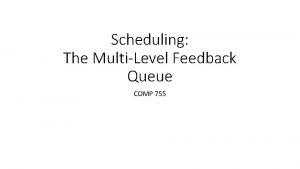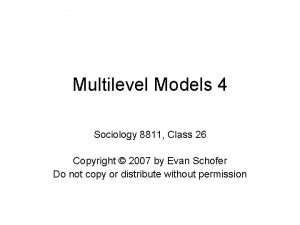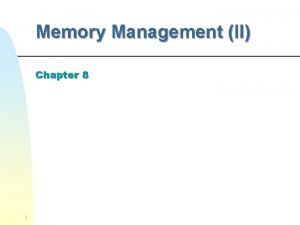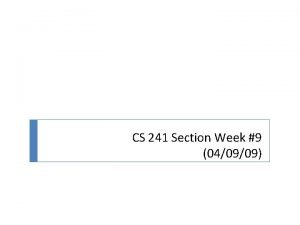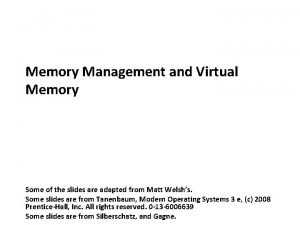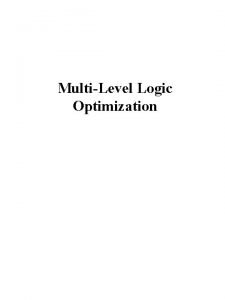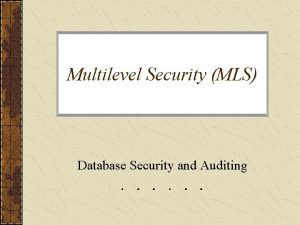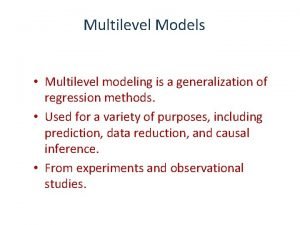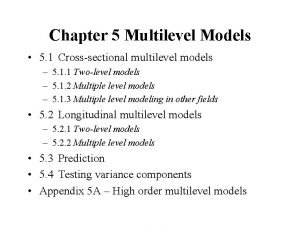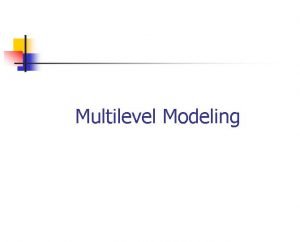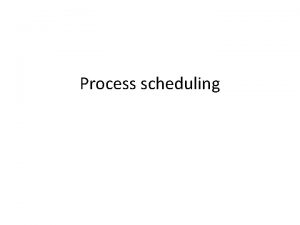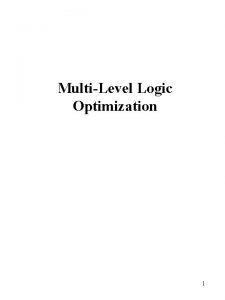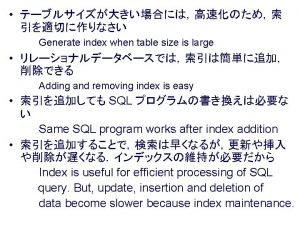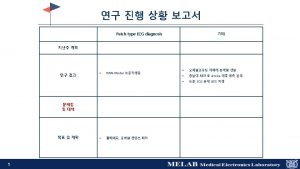Announcements Today Single level index review Multilevel index





















- Slides: 21

Announcements • Today – Single level index review – Multilevel index • Reading assignment: – Chapter 5 and Sections 6. 0 -6. 5

Program 1 post-mortem • I am in the process of grading it • Harshness of auto grading – Does not compile grade = 0 • We will have some way to replace lowest program • Please follow instructions exactly for turning in subsequent assignment

Review of Single Level Indexes

Primary Index • Index contains one index entry / block – Example index entry for a primary index on student # • <student# = 4173, block. ID = 937> The student # of the first record on block 937 is 4137 • Time to access in I/O operations – Without index: log 2 B – With index: log 2 Bidx + 1 The number of blocks in the file The number of blocks in index

Clustered Index • Index contains one entry / unique value of indexing field – Example index entry for clustered index on major • <major = “Comp. Sci”, block. ID = 937> The first block with a record whose major is Comp. Sci has blk. ID=937 • Time to access in I/O operations – Without index: log 2 B – With index: log 2 Bidx + 1 The number of blocks in the file The number of blocks in index

Secondary Indexes • Index contains every RID in the file – There are different ways to implement this – Example index entry for secondary index on major • <major = “Comp. Sci”, block. ID = 2877> Block 2877 (which is part of the index) contains RIDs for records where major is Comp. Sci • Time to access in I/O operations – Without index: B – With index: log 2 Bidx + 1 The number of blocks in the file The number of access the RID list blocks in index containing RID list block pointers

Example 1 and 2 in Chapter 14 • Setting file w/ 30, 000 fixed length records of 100 bytes on 1024 byte blocks – Records / block = 10 – # blocks in file = 3, 000 – Search for key w/o idx: log 2 3000 = about 12 • Make index on 9 byte ordering key, block ID is 6 bytes – 68 index entries / block, 3, 000 total index entries – 45 blocks in the index – Search for key w/ index = 1+log 2 45 = 7 I/Os

Example (continued) • Now search for non-ordering key: – Average is 1500 block reads • Construct secondary key on 9 byte non ordering key field: – Index entry still 15 bytes, 68 entries / block – But we need entry for each of the 30, 000 records • Need 442 blocks for index. – Binary search is log 2 442 = 9 block reads + 1 to get the record is 10.

Multilevel Indexes

Multilevel Indexes • Consider a clustered index on a non-key field • The index itself is an ordered file of (value, block. Ptr) pairs where value is a key field • We can thus construct a primary index on “value” • Add levels until the index fits in one block


Example (continued) • Construct multi level index for previous example – Secondary index had 68 entries / block and required 442 blocks on level 1 – Level two needs ceil(442 / 68) = 7 blocks – Level thee needs ceil(7 / 68) = 1 block – Stop • Search requires 4 block accesses

Inserts / Deletes are Problematic • In general, inserts and deletes to the file requires updating the index • Each level of the index is a physically ordered file thus updates are expensive • One solution: leave some space on each index for inserting new index entries B+ trees

B+ Trees • B+ trees are the most popular implementation of dynamic multilevel indexes • There are two types B+ tree index blocks – Internal nodes: contain index field values (used to guide the search) and pointers blocks in lower levels of the B+ tree (tree pointers) – Leaf nodes: contain values and matching RIDs

Trees


B+ Tree Properties • A B+ tree is always balanced (ie, distance from the root to leaf is the same for each leaf) • Let p be the maximum number of tree pointers on an internal block – Other than root, each internal page has at least ceil(p/2) tree pointers – A block with q tree pointers has q-1 search field values • Key aspect of B+ trees are graceful algorithms for handling insertions and delete

B+ Tree Insert Overview 1) Find leaf page on which to add entry 2) If there is room on leaf page insert and stop 3) If there is no room, overflow



 Pvu announcements
Pvu announcements R/announcements!
R/announcements! Church announcements
Church announcements Fahrenheit 451 pages
Fahrenheit 451 pages Kayl announcements
Kayl announcements General announcements
General announcements For today's meeting
For today's meeting Are you going to class today
Are you going to class today Today meeting or today's meeting
Today meeting or today's meeting Fingerprint ridge characteristics worksheet
Fingerprint ridge characteristics worksheet Today's lesson or today lesson
Today's lesson or today lesson Example of repitition
Example of repitition Multilevel page table
Multilevel page table Teaching multilevel esl classes
Teaching multilevel esl classes Comp 755
Comp 755 Multilevel model equation example
Multilevel model equation example Multilevel model equation example
Multilevel model equation example Multilevel paging in os
Multilevel paging in os Interfacing in embedded systems
Interfacing in embedded systems Multilevel page tables
Multilevel page tables Process virtual address space
Process virtual address space Multilevel modeling in spss
Multilevel modeling in spss














